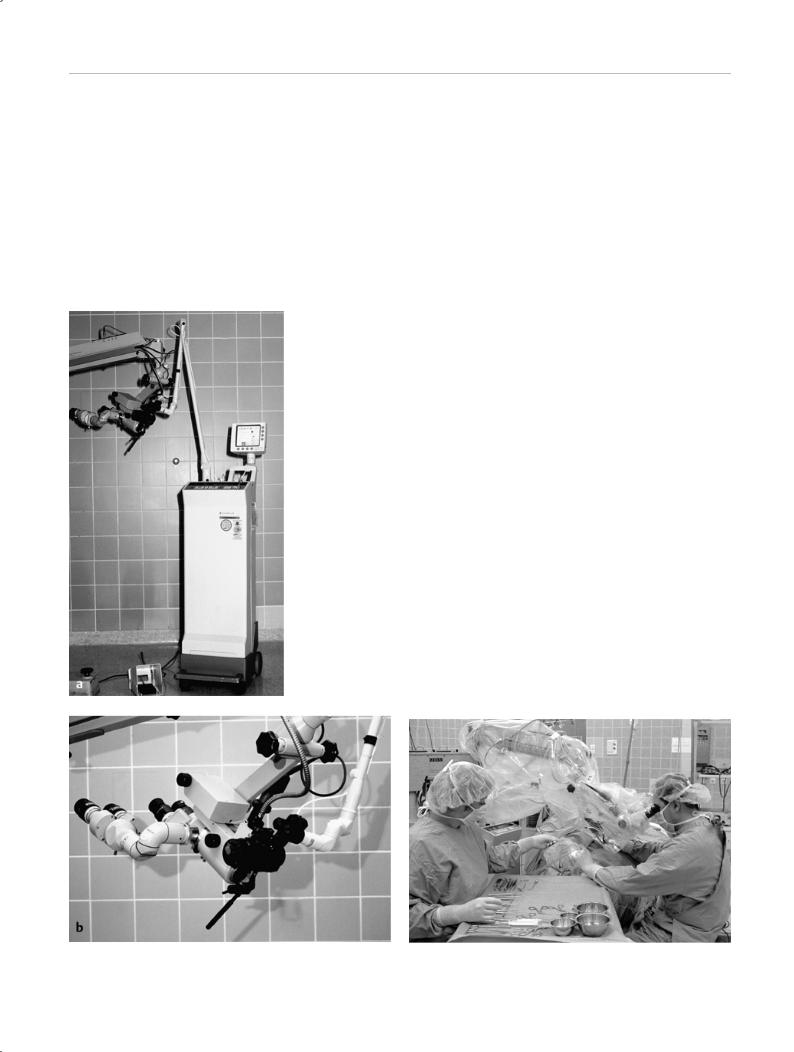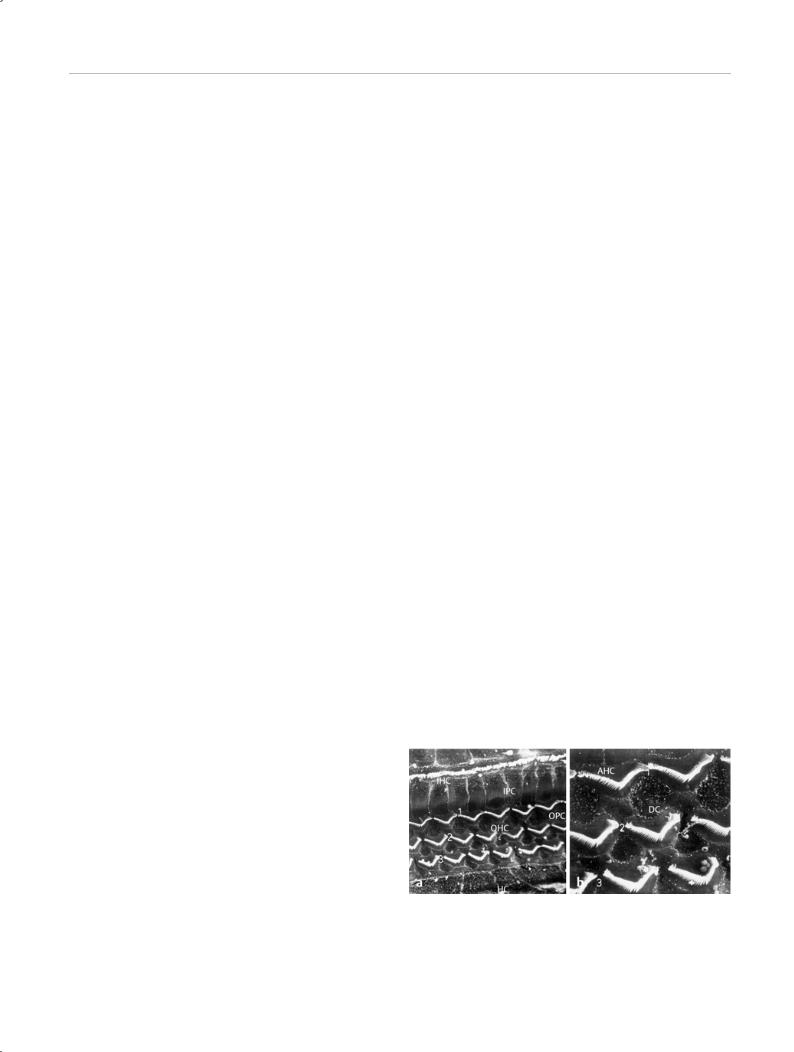
Учебники / Lasers in Otorhinolaryngology Huttenbrink
.pdf
20 Basic Principles of Medical Laser Technology
14 |
Bown SG. Phototherapy of tumors World. J Surg 1983; 7: 700– |
21 |
Altomare DF, Memeo V. Colonic explosion during diathermy |
|
709 |
|
colotomy. Dis Colon Rectum 1993; 3: 291–292 |
15 |
Philipp C, Bollow M, Krasicka-Rohde E, Fobbe F, Berlien HP. |
22 |
Axelrod EH, Kusnetz AB, Rosenberg MK. Operating room fires |
|
Color-coded duplex sonography as a new method for monitor- |
|
initiated by hot wire cautery. Anesthesiology 1993; 5: 1123– |
|
ing of laser-induced thermotherapy. SPIE Proceedings 1994; |
|
1126 |
|
2132: 287–294 |
23 |
Bailey MK, Bromley H, Allison JG, Conroy JM, Krzyzaniak W. |
16 |
Vogl TJ, Weinhold N, Muller P, Mack M, Scholz W, Philipp C, |
|
Electro-cautery-induced airway fire during traceostomy. An- |
|
Roggan A, Felix R. MR-controlled laser-induced thermotherapy |
|
esth Analg 1990; 71: 702–704 |
|
(LITT) of liver metastases: clinical evaluation. Roentgenpraxis |
24 |
Capizzi PJ, Clay RP, Battey MJ. Microbiologic activity in laser re- |
|
1996; 49: 161–168 |
|
surfacing plume an debris. Lasers Surg Med 1998; 23: 172–174 |
17 |
Poetke M, Philipp CM, Urban P, Berlien HP. Interstitial laser |
25 |
Philipp C, Albrecht H, Hug B, Berlien H-P, Müller G. Significance |
|
treatment of venous malformations. Med Laser Appl 2001; 16: |
|
of Laser Safety. Lasers in Gynecology. Berlin, Heidelberg: |
|
111–119 |
|
Springer-Verlag, 1992: 435–446 |
18 |
Unfallverhütungsvorschriften der Berufsgenossenschaften, BG |
26 |
Rockwell RJ. Laser Accidents: Reviewing thirty years of inci- |
|
V2 (Laser), (ehem. UVV VBG 93) |
|
dents: What are the concerns – old and new. J Laser Application |
19 |
Medizinproduktegesetz (MPG) |
|
1994; 6: 203–211 |
20 |
Medizinprodukteanwendergesetz (MPAG) |
|
|

21
2 Lasers in Otology
S. Jovanovic
T Contents
Introduction . . . . . . . . . . . . . . . . . . . . . . . . . . . . . . . . . . . . . . |
22 |
Role of Various Lasers in Otology . . . . . . . . . . . . . . . . . . . 23
Suitability of Different Wavelengths . . . . . . . . . . . . . . . . . 23
Argon and KTP Lasers . . . . . . . . . . . . . . . . . . . . . . . . . . . . . . 23
CO2 Laser . . . . . . . . . . . . . . . . . . . . . . . . . . . . . . . . . . . . . . . . . . 23
Er:YAG Laser . . . . . . . . . . . . . . . . . . . . . . . . . . . . . . . . . . . . . . 23
Nd:YAG and Diode Lasers . . . . . . . . . . . . . . . . . . . . . . . . . . . 24
Delivery Systems . . . . . . . . . . . . . . . . . . . . . . . . . . . . . . . . . . 24
Micromanipulators . . . . . . . . . . . . . . . . . . . . . . . . . . . . . . . . . 24
Fibers . . . . . . . . . . . . . . . . . . . . . . . . . . . . . . . . . . . . . . . . . . . . . 25
Scanner Systems . . . . . . . . . . . . . . . . . . . . . . . . . . . . . . . . . . . 25
Laser Otoscope . . . . . . . . . . . . . . . . . . . . . . . . . . . . . . . . . . . . . 25
Thermal and Acoustic Effects of Laser Radiation . . . . . . 26
Temperature Measurements . . . . . . . . . . . . . . . . . . . . . . . . 26
Acoustic Measurements . . . . . . . . . . . . . . . . . . . . . . . . . . . . 27
Experimental Animal Studies . . . . . . . . . . . . . . . . . . . . . . . 28
Laser Use in the External Auditory Canal . . . . . . . . . . . 29
Vascular Lesions . . . . . . . . . . . . . . . . . . . . . . . . . . . . . . . . . . . 29
Polyps and Granulations . . . . . . . . . . . . . . . . . . . . . . . . . . . . 29
Exostoses . . . . . . . . . . . . . . . . . . . . . . . . . . . . . . . . . . . . . . . . . . 29
Stenoses . . . . . . . . . . . . . . . . . . . . . . . . . . . . . . . . . . . . . . . . . . . 30
Debulking Inoperable Tumors . . . . . . . . . . . . . . . . . . . . . . . 30
Laser Use on the Tympanic Membrane . . . . . . . . . . . . . 30 Secretory Otitis Media . . . . . . . . . . . . . . . . . . . . . . . . . . . . . . 31 Operative Technique . . . . . . . . . . . . . . . . . . . . . . . . . . . . . . . 31 Acute Otitis Media with Vestibulocochlear
Complications . . . . . . . . . . . . . . . . . . . . . . . . . . . . . . . . . . . . . 32 Acute Eustachian Tube Dysfunction . . . . . . . . . . . . . . . . . 32 Barotrauma . . . . . . . . . . . . . . . . . . . . . . . . . . . . . . . . . . . . . . . . 33 Transtympanic Endoscopy . . . . . . . . . . . . . . . . . . . . . . . . . . 33 Tympanic Membrane Perforations and Atrophic
Scars . . . . . . . . . . . . . . . . . . . . . . . . . . . . . . . . . . . . . . . . . . . . . . 33 Graft Fixation for Tympanic Membrane Defects . . . . . . 34 Epidermoid Cysts of the Tympanic Membrane . . . . . . . 34
Laser Use in the Middle Ear . . . . . . . . . . . . . . . . . . . . . . . . 34 Medialization of the Malleus . . . . . . . . . . . . . . . . . . . . . . . . 34 Malleus Fixation . . . . . . . . . . . . . . . . . . . . . . . . . . . . . . . . . . . 34 Tympanosclerosis . . . . . . . . . . . . . . . . . . . . . . . . . . . . . . . . . . 35 Ossicular and Prosthetic Dislocation after
Tympanoplasty . . . . . . . . . . . . . . . . . . . . . . . . . . . . . . . . . . . . 35 Chronic Otitis Media . . . . . . . . . . . . . . . . . . . . . . . . . . . . . . . 35 Cholesteatoma . . . . . . . . . . . . . . . . . . . . . . . . . . . . . . . . . . . . . 36 Vascular Lesions . . . . . . . . . . . . . . . . . . . . . . . . . . . . . . . . . . . 37 Otosclerosis . . . . . . . . . . . . . . . . . . . . . . . . . . . . . . . . . . . . . . . 38 Safe and Effective Energy Parameters for CO2 Laser Stapedotomy . . . . . . . . . . . . . . . . . . . . . . . . . . . . . . . . . . . . . . 39
Surgical Technique of CO2 Laser Stapedotomy . . . . . . . . 39 Special Cases . . . . . . . . . . . . . . . . . . . . . . . . . . . . . . . . . . . . . . . 41 Obliterative Otosclerosis . . . . . . . . . . . . . . . . . . . . . . . . . . 41 Overhanging Facial Nerve . . . . . . . . . . . . . . . . . . . . . . . . . 41 Overhanging Promontory . . . . . . . . . . . . . . . . . . . . . . . . . 42 Inaccessible Footplate . . . . . . . . . . . . . . . . . . . . . . . . . . . . 42 Floating Footplate . . . . . . . . . . . . . . . . . . . . . . . . . . . . . . . . 42 Problems in Revision Procedures . . . . . . . . . . . . . . . . . . . . 42 Technique of CO2 Laser Revision Stapedotomy . . . . . . . 43
Author’s Results with CO2 Laser
Stapedotomy . . . . . . . . . . . . . . . . . . . . . . . . . . . . . . . . . . . . . . . 43 Results of Initial Operations . . . . . . . . . . . . . . . . . . . . . . . 43 Complications in Primary Operations . . . . . . . . . . . . . . 44 Results of Revision Operations . . . . . . . . . . . . . . . . . . . . 44 Complications of Revision Operations . . . . . . . . . . . . . 45
Laser Versus Conventional Surgery . . . . . . . . . . . . . . . . . . 45
Laser Use in the Inner Ear . . . . . . . . . . . . . . . . . . . . . . . . . 46
Cochleostomy . . . . . . . . . . . . . . . . . . . . . . . . . . . . . . . . . . . . . . 46
Peripheral Vestibular Disorders: Benign Paroxysmal
Positional Vertigo and Endolymphatic Hydrops . . . . . . . 46
Tinnitus and Sensorineural Hearing Loss . . . . . . . . . . . . . 47
Laser Use in the Internal Auditory Canal . . . . . . . . . . . . 47
Acoustic Neuroma . . . . . . . . . . . . . . . . . . . . . . . . . . . . . . . . . . 47
Conclusions . . . . . . . . . . . . . . . . . . . . . . . . . . . . . . . . . . . . . . . . 48
References . . . . . . . . . . . . . . . . . . . . . . . . . . . . . . . . . . . . . . . . . 48

22 Lasers in Otology
T Abstract |
1965, were among the first to investigate the potential of |
|
lasers in otologic surgery, initially using a ruby laser to car- |
||
Ongoing efforts to refine surgical techniques in otology are |
ry out inner ear surgery in pigeons. Later the same group |
|
of authors used the argon laser on the organ of Corti in |
||
based on the desire to minimize the critical aspects of these |
guinea pigs to produce surface changes in the stria vascu- |
|
procedures, especially the hazards to the inner ear. One ap- |
laris without damaging the bony cochlea [8]. Sataloff [9], |
|
proach is to optimize conventional operative techniques |
in 1967, was the first to experimentally vaporize isolated |
|
through the precise and controlled use of lasers. This chap- |
human footplates with a neodymium:glass laser. Kelemen |
|
ter deals with the various indications for noncontact laser |
et al. [10] were able to induce bleeding in the inner ear of |
|
use in the external auditory canal, on the tympanic mem- |
mice with pulsed ruby and neodymium:yttrium aluminum |
|
brane, and in the middle and inner ear and reviews the sur- |
garnet (Nd:YAG) lasers. Wilpizeski et al. [11] produced se- |
|
gical techniques involved in the use of various laser wave- |
lective vestibular ablation in monkeys by irradiating the |
|
lengths, placing special emphasis on the techniques that |
semicircular canals with an argon laser. However, the con- |
|
are best for specific indications. For example, today it is |
flicting experimental data prevented clinical application. |
|
hard to conceive of stapes surgery without lasers, both in |
Escudero et al. [12] used an argon laser in human tympa- |
|
primary operations and revision surgery. Other indications |
noplasties to spot-weld a temporalis fascia graft to the |
|
for laser use are chronic hyperplastic mucosal suppuration, |
margin of the perforated eardrum. DiBartolomeo and Ellis |
|
cholesteatoma, tympanosclerosis, malleus fixation, adhe- |
[1] reported on the clinical application of argon laser sur- |
|
sive processes, external auditory canal exostoses near the |
gery of the external auditory canal and middle ear for the |
|
tympanic membrane, and vascular lesions of the middle |
treatment of various soft-tissue abnormalities (adhesions, |
|
ear. Particularly in revision surgery, the laser often pro- |
granulations, persistent stapedial artery, etc.), the ossicular |
|
vides a surgical treatment option that would not be avail- |
chain, and bony lesions of the external auditory canal (ex- |
|
able with conventional instruments. Lasers applied to the |
ostoses, osteomas). Finally, Perkins [13] introduced the ar- |
|
tympanic membrane in the operative treatment of middle |
gon laser in clinical stapes surgery in 1980. Silverstein et |
|
ear ventilation problems, transtympanic endoscopy, and |
al. [14] first used the potassium-titanyl-phosphate (KTP)- |
|
the treatment of perforations are additional procedures |
532 laser in stapes surgery in 1989 and Lesinski [15] the |
|
that can be carried out on an ambulatory basis. With regard |
carbon dioxide (CO2) laser also in 1989. Among the pulsed |
|
to the inner ear, the use of lasers in the treatment of pe- |
laser systems, the erbium (Er):YAG laser was first used |
|
ripheral vestibular disorders as well as tinnitus and sen- |
clinically for otologic surgery in 1992 [16]. Recently, an ex- |
|
sorineural hearing loss is discussed. The chapter concludes |
perimental study was published on the use of fiberoptically |
|
with a description of laser use in the surgical treatment of |
transmitted near-infrared diode lasers in otologic surgery |
|
acoustic neuroma. |
[17]. To date, their clinical use has been limited to a few |
|
|
cases. More recently, otosurgical applications of the argon, |
|
T Introduction |
KTP-532, CO2 and Er:YAG lasers have been described in |
|
various publications, with some degree of controversy [1, |
||
In otology, surgical techniques using conventional instru- |
13–15, 19–71, 73–94]. |
|
|
||
ments are widely practiced and have been established for |
Many otosurgical procedures involve removing large |
|
many years. All manual instrument techniques involve the |
amounts of bone and soft tissue with conventional instru- |
|
manipulation of tissues (external auditory canal, tympanic |
ments. In contrast, the application of laser energy using a |
|
membrane, middle ear mucosa, ossicular chain, etc.) to |
noncontact technique allows for vibration-free tissue re- |
|
produce and transmit mechanical energy. Some of the in- |
moval and enables surgeons to carry out some procedures |
|
struments, such as drills, cause additional energy transmis- |
with greater precision, leading to better results and fewer |
|
sion through vibrations. In the past, various types of energy |
complications. The transmission of potentially harmful en- |
|
have been used to eliminate these unwanted effects during |
ergy to the surrounding tissues can be limited in a very pre- |
|
the surgical alteration of tissues. For a review see the article |
cise way by selecting the optimal laser parameters for re- |
|
“The Argon Laser in Otology” by DiBartolomeo and Ellis [1]. |
moving particular types of tissue. |
|
Clarke, for example, used electrocautery needles in 1973 to |
|
|
remove exostoses from the external auditory canal [2]. |
For the present, lasers are still not widely used in otologic |
|
Mülwert and Voss used ultrasound in 1928 for the treat- |
surgery. Using a laser means leaving behind traditional, es- |
|
ment of otosclerosis [3]. Krejci, in 1952, was the first to sur- |
tablished surgical techniques with conventional instru- |
|
gically expose the mastoid and selectively ablate the ves- |
ments. The safe and effective use of lasers in otology re- |
|
tibular apparatus with ultrasound as a treatment for |
quires knowledge of the basic principles of laser–tissue in- |
|
Ménière’s disease [4]. Sjöberg and Stahle optimized the ul- |
teractions and the possible applications of laser use in oto- |
|
trasound therapy for Ménière’s disease in 1965, but this |
logic surgery. However, theoretical knowledge is no |
|
treatment was not widely accepted due to lack of precision |
guarantee for achieving good surgical results, which de- |
|
in selective ablation [5]. Similarly, the selective cryosurgi- |
pend more upon clinical experience acquired in a super- |
|
cal destruction of anatomic structures has failed to offer |
vised setting. |
|
significant advantages [6]. |
In this chapter first the general principles of laser use in |
|
In the continuing search for a precise and “noncontact” |
||
otologic surgery are reviewed. Then the following sections |
||
form of tissue alteration, the application of laser beams ap- |
deal with clinical laser application in selected otologic dis- |
|
peared to be the ideal approach. Stahle and Högberg [7], in |
orders. |

Role of Various Lasers in Otology 23
T Role of Various Lasers in Otology
CO2 Laser
Laser–tissue interactions have already been dealt with in some detail in Chapter 1. Here we consider the specific features of these lasers as they apply to otologic surgery.
Suitability of Different Wavelengths
Not infrequently, the selection of a laser for otosurgical procedures is dictated by the availability of a wavelength intended for use in other ENT regions. The tissue effects of lasers and the extent of the thermal damage zone in the surrounding tissues can vary considerably among lasers with different wavelengths. The ability to transmit the beam through fiberoptic cables is another factor that has an important bearing on laser applications. Finally, the individual enthusiasm for a new technology can also be the decisive factor in choosing a particular laser.
Three types of continuous-wave (CW) thermal laser are currently used in otologic surgery: the argon laser (which emits at wavelengths of 488 nm and 514 nm), the KTP laser (532 nm), and the CO2 laser (10,600 nm). The Er:YAG laser (2940 nm) is a pulsed laser that produces an oligothermal tissue effect.
Argon and KTP Lasers
The argon and KTP lasers are discussed together because of their similar laser–tissue interactions. They emit energy in the visible range of the electromagnetic spectrum.
In some circumstances, a low-intensity argon laser beam can pass through bone tissue without altering it. At high energies, the argon beam vaporizes bone and is used for laser fenestration of the stapes footplate in otosclerosis. The suitability of the argon laser for stapedotomy is doubtful, however, due to the low absorption coefficient of its radiation in the stapes footplate. Its effectiveness depends strongly on the degree of pigmentation of the treated tissue, resulting in poor reproducibility of its ablative (perforative) effect [56, 62, 63]. Moreover, the light from visible-wavelength lasers passes through the perilymph with almost no interaction. Because it is strongly absorbed by the perfused tissue and pigmented cells, it can pose a threat to inner ear structures. Clinical experience with these lasers to date, however, has not confirmed this potential theoretical hazard. The most likely explanation for this is that the beam delivered by an optical fiber diverges immediately after leaving the fiber. The power density falls off so rapidly that the laser radiation still being absorbed in the tissue causes no thermal damage to the inner ear structures because of its low power density.
Argon and KTP laser light is strongly absorbed by hemoglobin, making it an excellent tool for hemostasis. Wellvascularized or inflamed tissues can be effectively treated with very little bleeding by coagulating the tissue before cutting or vaporizing it. These lasers can also be used to destroy cholesteatoma cells within the middle ear and mastoid [83, 95, 96].
The continuous beam of the CO2 laser is effective for removing soft tissue, and it can vaporize thin bony structures when focused to a small spot [56, 62, 63]. The CO2 laser beam is more strongly absorbed by bone than the argon laser, with the result that the CO2 laser is more effective, can create a more reproducible stapedotomy opening, and causes less collateral thermal damage.
One of the main advantages of the far-infrared emission of the CO2 laser is its strong absorption by water, resulting in a shallow penetration depth of only 0.01 nm from the irradiated surface. This property of CO2 laser light is particularly useful in stapes surgery. During a stapedotomy, the perilymph completely absorbs the CO2 laser energy and thus protects the inner ear structures from direct injury.
The hemostatic effect of CO2 laser is poorer than that of the argon and KTP lasers. It can be enhanced, however, by deliberately defocusing the laser beam with the micromanipulator or by using a microprocessor-controlled scanner (see Delivery Systems below). As a result, this laser is generally satisfactory for all surgical procedures in the middle ear. The CO2 laser is also applied in cholesteatoma surgery [69, 97].
Er:YAG Laser
The effect of the pulsed Er:YAG laser differs from that of the CW CO2 laser. By emitting short bursts of high power density in the microsecond range, the Er:YAG laser induces “nonlinear” processes, known also as “photoablation.” The exposure times, and thus the duration of the temperature rise in the tissue, are so short that heat conduction is virtually eliminated. Thus, the target tissue is ablated with no significant heating of the surrounding structures. However, due to the explosion-like nature of photoablation, pulsed lasers produce acoustic phenomena (pressure and shock waves) which can damage the inner ear. The wavelength of the Er:YAG laser has a higher absorption coefficient in bone (stapes footplate) than that of the CO2 laser. Scholz and Grothues-Spork [98] note that Er:YAG laser radiation is absorbed mainly by water and collagen, whereas CO2 laser waves are absorbed by inorganic salts.
The Er:YAG laser offers the greatest advantages when used on bony structures [57, 63, 65, 99–103]. The tissue-ablating effects of the pulsed Er:YAG laser permit the precise and controlled treatment of middle ear structures with low, reproducible ablation rates. Thermal side effects are less extensive than with CW lasers.
Given the strong absorption of Er:YAG laser radiation by water, the beam has a low penetration depth in perilymph when used for stapedotomy. However, the pressure waves generated by the pulsed beam in the perilymph are higher than with CW lasers and can cause inner ear injuries [63, 71, 78, 85, 102]. Clinical studies have shown that transient or permanent high-frequency hearing loss and tinnitus can result from Er:YAG laser use ([85, 104] and personal experience). These safety concerns have reduced the fre-

24 Lasers in Otology
quency of clinical use of the erbium laser [85, 86, 88–90, |
Nd:YAG and Diode Lasers |
101, 103]. |
|
Today, the Er:YAG laser is considered less safe than the CO2 |
The Nd:YAG laser (1064 nm) and the new diode lasers |
(810 nm, 830 nm, and 940 nm) emit at near-infrared |
|
laser and can be hazardous when used in stapes surgery. |
wavelengths and can be transmitted through fiberoptic ca- |
In addition, the Er:YAG laser is not effective for hemostasis. |
bles. To date they have been used only sporadically in oto- |
When bleeding occurs, the Er:YAG laser beam is complete- |
logic surgery due to their high penetration depth in tissue. |
ly absorbed by the extravasated blood and no longer reach- |
|
es the target tissue. This is a particular disadvantage in re- |
The hemostatic effect of the Nd:YAG laser and various di- |
vision surgery. |
ode lasers is very good despite their nonspecific absorption |
|
by blood owing to the greater penetration and scatter of |
|
their radiation. |
Delivery Systems
Micromanipulators
CO2 and Er:YAG laser energy cannot be transmitted efficiently through optical fibers without significant losses. The output of the CO2 laser is delivered to the operative site through an articulated arm and a micromanipulator coupled to an operating microscope (Fig. 2.1 a, b). A joystick is used to move the laser beam within the operative field. The micromanipulator and the attached articulated arm of the laser can limit the mobility of the operating microscope. The new generation of micromanipulators, with their lower weight (approximately 500 g) and size and shape better adapted to otologic surgical requirements, make the microscope easier to handle and allow the comfortable use of additional surgical instruments (Fig. 2.2).
The CO2 laser can be used with micromanipulators allowing a spot size of 0.18–0.2 mm at a working distance of 250 mm. With a good beam profile and perfect alignment of the helium neon (HeNe) aiming beam with the CO2 treatment beam, extremely fine microsurgical work can be carried out on middle ear structures. Newer systems also offer a variable working distance of 200–400 mm, which can be changed simply by turning a knob on the micromanipulator, eliminating the need for cumbersome lens changes. This is particularly advantageous when the CO2
Fig. 2.1 a CO2 laser with an articulated arm and micromanipulator |
Fig. 2.2 Intraoperative setup for middle ear surgery with the CO2 la- |
(Lumenis model 40C). b Precision micromanipulator with a variable fo- |
ser. |
cal distance f = 200–400 mm (Lumenis Acuspot 712). |
|

Role of Various Lasers in Otology 25
laser is used for other indications requiring a different focal distance.
The Er:YAG laser currently available for clinical use has been designed exclusively for otologic surgery and has an integrated microscope (TwinEr, Carl Zeiss). It is equipped with a micromanipulator with a working distance of 300 mm, which some ear surgeons consider to be too large. The spot size at the focal point is approximately 0.4 mm.
Delivery systems can differ greatly in their ability to transmit laser power. With the CO2 laser, the delivered output ranges between 70 % and 90 % of the primary output, depending on the laser system and micromanipulator. The surgeon must be knowledgeable about the amount of power loss and use a correspondingly higher power setting on the laser device to correct for it and achieve the desired effect on middle ear structures.
The main advantage of the micromanipulator delivery system compared with fiberoptic carriers is the unobstructed view of the treatment site. The laser beam remains focused at a predefined working distance, thus maintaining its power density when focused onto the selected site.
Fibers
The output from lasers that emit at visible and near-infra- red wavelengths is delivered through an optical fiber mounted in a handpiece that is controlled separately from the microscope (Fig. 2.3). This can increase the flexibility of the delivery device and is helpful in treating hard-to- reach sites (e. g., cholesteatomas, the anterior crus of the stapes, etc.).
Because the power density of fiberoptically delivered lasers is maximal only at the output end of the fiber, the fiber
Fig. 2.3 Hand-held applicator designed by Gherini-Causse (Endo-Otoprobe).
tip must be held close to the target site to achieve the desired effect. As a result, the fiber and fiber-bearing applicator can partially obscure the operative field and the structure being treated.
Scanner Systems
When a CO2 laser beam is directed with microprocessorcontrolled rotating mirrors known as scanner systems (SurgiTouch, Lumenis), the beam is automatically tracked in a spiral-shaped pattern within a designated pulse duration (Fig. 2.4 a, b). In this way the CO2 laser can deliver high power densities even over a relatively large treatment area with minimal collateral effects. At a working distance of 250 mm, the size of the treated area can be freely selected in accordance with the local anatomic configuration and the desired size of the perforation. In middle ear surgery, the treated areas will range from 0.3 mm to 0.8 mm in diameter. Areas of 1–3 mm are used in tympanic membrane procedures. Thus, an opening of a specified diameter can generally be made in the stapes footplate or tympanic membrane when the correct laser parameters are used.
At present, no scanner systems are available for the Er:YAG laser used in otologic surgery.
Laser Otoscope
Designed for laser myringotomy, the CO2 laser otoscope is a special delivery system (OtoScan, Lumenis) consisting of a mirror system with a built-in video camera (Fig. 2.5). Ear specula of assorted lengths and diameters are available for
Fig. 2.4 Microprocessor-controlled scanner for the rotary application of laser energy. a SurgiTouch scanner (Lumenis). b Spiral lasing pattern applied within 0.03–0.05 seconds.
Fig. 2.5 Close-up view of the otoscope (OtoScan, Lumenis). The otoscope consists of a mirror system (center), a video camera (right), and ear speculum attachments of varying sizes (left). Mounted on the otoscope is a computer-controlled scanner system, to which the articulated mirror arm is connected.

26 Lasers in Otology
both children and adult patients. The diameter of the fo- |
lasts for several seconds. The duration of the strong, tran- |
||
cused laser beam is approximately 400 µm. The otoscope |
sient heating effect approximates the duration of the laser |
||
is used in conjunction with a computer-controlled scanner |
pulse, which was only 0.05 s or 0.1 s. Longer application |
||
system. |
times would lead to higher, more prolonged temperature |
||
|
peaks due to the greater energy delivery. The potential of |
||
|
laser radiation to cause thermal injury to biological struc- |
||
Thermal and Acoustic Effects of |
tures depends both on the maximum temperature reached |
||
and on the length of time the tissue is exposed to the ele- |
|||
Laser Radiation |
|||
vated temperature. |
|
||
Tissue removal with a laser beam is based on the physical |
In all systems, increasing the power and energy density of |
||
principles of laser energy absorption in tissue and its con- |
the laser beam leads to an increase in the temperature in- |
||
version into other forms of energy, initiating thermal and |
crements. With a CO2 laser operating in the CW and super- |
||
acoustic processes. The possible hazards posed by thermal |
pulse modes, the maximum temperature rise at a distance |
||
and acoustic phenomena must be recognized and under- |
of 2 mm past the stapes fenestra in the effective power |
||
stood in quantitative terms. |
density range needed for multiple applications averages |
||
|
8.8 °C and 4.6 °C, respectively, at a power of 8 W and a |
||
When lasers are used in otologic surgery, the structures |
pulse duration of 0.05 s. For a single-shot application with |
||
that are most susceptible to injury are the cochlea and the |
the SurgiTouch Scanner in the CW mode, the average tem- |
||
labyrinth. Prior to clinical laser use it is necessary to inves- |
perature rise is 4.4 °C at a power setting of 20 W and a |
||
tigate the physical processes and assess the potential for |
pulse duration of 0.05 s. Given the short exposure time, |
||
harm. Since losses occur whenever energy is transported, |
these temperature increases do not appear to be harmful |
||
laser light does not pose a critical threat to structures more |
for the inner ear (Fig. 2.6). |
|
|
distant from the inner ear. On the other hand, laser appli- |
Laser light acting directly on the perilymph after perforat- |
||
cation in direct proximity to the oval window niche (e. g., |
|||
laser stapedotomy) is particularly hazardous to inner ear |
ing the stapes footplate does not pose an increased risk to |
||
structures. Similarly, prolonged laser application without |
inner ear structures with the CO2 lasers tested in our study. |
||
sufficient pauses can produce a critical summation of tis- |
When multiple applications are used to make a sufficiently |
||
sue effects. The phenomena associated with laser stapedot- |
large opening in the footplate, a slight rise occurs in the |
||
omy have been rigorously investigated and the results |
basal fluid temperature. But when the laser pulses are ap- |
||
have been applied to other laser procedures in otology. To |
plied at a low repetition rate (≤1 Hz), there is no evidence |
||
illustrate the problem, a summary of the results of studies |
that the additive effect of the temperature increments has |
||
by the present author on the suitability of various lasers |
a deleterious effect on inner ear structures. In contrast, the |
||
for stapes surgery is given below [41, 42, 50, 53, 55, 60, 61, |
temperature increases following argon laser treatment |
||
63, 68, 70, 71, 78]. |
show almost no site-dependent variations and exhibit a |
||
|
large scatter (from 5.5 °C to 13 °C). Given the low absorp- |
||
When laser energy is applied to middle ear structures, the |
tion of argon laser light by the perilymph, the temperature |
||
results are a surfaceand wavelength-dependent absorp- |
increases are due to the absorption of scattered radiation |
||
tion of the radiation and its conversion to thermal energy. |
by the thermoprobe itself. |
|
|
This heat then spreads from the target site to adjacent ar- |
The pulsed lasers we investigated were found to cause |
||
eas, including the inner ear. In a laser stapedotomy, local |
|||
absorption-dependent heating of the perilymph occurs at |
smaller temperature increases. In the pulsed systems as |
||
the application site. Heat is also transferred into the coch- |
|
|
|
lea directly behind the perforation, potentially causing |
|
|
|
thermal injury to more deeply situated cochlear structures. |
|
|
|
Focal energy delivery into the fluid leads to varying degrees |
P |
|
|
of local, energy-dependent vaporization followed by rapid, |
Laser pulse |
|
|
intense, radiationand flow-related heat exchange pro- |
|
||
|
|
||
cesses. Temperature increases depend on the laser energy |
T(°C) |
|
|
needed to produce an adequate stapedotomy opening and |
|
||
|
|
||
the resulting convection currents. Thermal conduction is |
6,8 |
Distance: 1 mm |
|
of only minor importance in fluids briefly exposed to a la- |
|
|
|
ser beam.
Temperature Measurements
Based on the present author’s measurements of a calorically approximated cochlear model, the time course of local temperature changes in the cochlea in response to laser application shows a rapid, transient, convection-induced temperature rise that becomes maximal at about the end of the laser pulse and then shows a gradual cooling that
T(°C)
4,4 |
|
Distance: 2 mm |
|
|
|
|
|
|
|
0 |
100 |
200 |
300 |
t (ms) |
Fig. 2.6 Time course ∆T (°C) of fluid heating in the cochlear model at a perpendicular distance of 1 mm and 2 mm behind the fenestra for a continuous-wave CO2 laser used with a scanner (power output 20 W, pulse duration 0.05 seconds, power density 80,000 W/cm2, scan diameter 0.6 mm).

Role of Various Lasers in Otology 27
well, increasing the energy density and the number of pulses (= more total energy) results in higher measured temperatures. The Er:YSGG laser (<5 °C) and the Er:YAG laser (5.5 °C) produced the lowest temperature peaks at a distance of 2 mm past the stapes fenestra in the effective energy density range and necessary number of pulse applications.
These results indicate that a stapedotomy opening made with a CO2 laser in the CW and superpulse modes over a relatively broad range of power densities will not cause thermal damage to the inner ear. We recommend working with low energies by selecting a small beam diameter and short pulse duration (≤0.05 s). Among the pulsed laser systems, the erbium lasers appear to be most suitable for stapedotomy from a thermal standpoint.
Acoustic Measurements
Besides thermal stresses, acoustic phenomena (pressure and shock waves) also result from laser application and can cause additional damage to the inner ear. Hence they are another important criterion in the selection of suitable laser types and modes of delivery.
The acoustic effects associated with laser surgery are based on two different physical mechanisms. In the first, the photoablative effect of pulsed laser systems generates pressure waves in the lased tissue. These waves can disrupt the tissue and, when the laser is applied to the auditory ossicles, can create a vibratory stimulus in the ossicular chain similar to that caused by impulse noise. The physiologic transmission of the vibrations across the auditory ossicles to the inner ear can result in “noise trauma.”
In the second mechanism, which occurs in laser stapedotomy, the energy from any laser system can cause local, transient heating and vaporization of the perilymph during and especially after perforation of the stapes footplate. This creates turbulent convection currents and causes the formation of gas and steam bubbles, which implode on cooling (cavitation) and trigger a stochastic train of pressure impulses in the cochlea. These impulses also stimulate the physiologic vibratory structures of the inner ear (basilar membrane and organ of Corti), producing a type of im- pulse–noise trauma in the inner ear similar to that caused by sound transmitted via the tympanic membrane and middle ear.
When the CO2 laser is used in the CW mode, the cavitationinduced, stochastic pressure impulses in the fluid produce a noise-like signal pattern with spectral amplitude peaks in the range of 2–7 kHz. The thermally induced signal generation begins a moment after the start of the laser pulse and lasts longer than the pulse itself because of delayed cooling. The duration of the “noise” exposure corresponds roughly to the duration of laser application. When the CO2 laser is used in the superpulse mode, the pressure variations reflect the temporal profile of the laser device (series of short laser pulses with a constant peak pulse power) and display higher pressure amplitudes compared with the CW mode. Because the mean power setting is controlled by the
pulse frequency, the temporal profile at higher power settings shows a higher frequency of the generated pressure impulses with no change in the amplitudes.
In the CW mode, increasing the power density (and thus the laser energy) leads to greater fluid heating with increased bubble formation and implosion, resulting in higher signal amplitudes. The measured signal patterns, which were converted to a comparable sound pressure transmitted through the external auditory canal, showed that tripling the power density led to a 10-dB increase in the peak sound pressure level (from approximately 120 dB-SPL to 130 dB-SPL). We found a maximum peak pressure level of approximately 135 dB-SPL. Lasing in the superpulse mode with a peak pulse power of approximately 300 W and a small beam diameter (180 µm) generates higher peak sound pressure levels of approximately 145 dB-SPL, which are independent of the mean power setting and pulse frequency.
Laser application through an existing stapes fenestra does not increase the peak sound pressure level in either operating mode compared with initial laser fenestration. Increasing the pulse duration from 0.05 s to 0.1 s does not cause higher amplitudes in either mode, but it does double the exposure time and also the noise dose.
These results show that laser energy is the only parameter to critically affect the induction of pressure waves in the ear.
With the argon laser, the only frequency components measured were low-frequency signals. This means that cavitation did not occur in the fluid at the laser settings used. We can attribute this to the low absorption of the argon wavelength, which leads to almost complete transmission of the argon beam in the model, causing very little rise in the local fluid temperature.
The pressure–time curve for pulsed laser systems shows a single, short pressure impulse whose effective duration is approximately equal to the laser pulse duration (Er:YSGG laser approximately 600 µs, Er:YAG laser approximately 250 µs) based on the “10-dB down duration” used for impulse noise. We did not find measured peak sound pressure level to be dependent on energy density with the Er:YSGG laser. With the Er:YAG laser, however, the levels did rise slightly with the energy setting. The comparable peak sound pressure levels were higher with pulsed lasers than with CO2 lasers in the CW and superpulse modes. The highest levels, at 175 dB-SPL, occurred with the Er:YAG laser.
When interpreting the results, we drew upon studies of impulse–noise effects (which show similar signal patterns) as documented in tolerance level diagrams. The sound pressure level (SPL)–exposure time diagram is used to determine the risk of hearing loss based on the critical noise dose defined by Pfander [105]. When exposure exceeds this tolerance limit, it is reasonable to expect that permanent noise-induced hearing loss will occur. (The values in the diagram represent an extrapolation of the tolerance limits from occupational medicine with an equivalent sustained noise level of 85 dB-A over an 8-hour work day.) The

28 Lasers in Otology
180
170
160
150
140
130
120
Tolerance |
level |
|
Number of shots 1 Multiple
CO2 (CW mode)
CO2 (superpulse mode)
Er:YSGG
Er:YAG
110 |
|
|
100 µs 1 |
10 100 ms 1 |
10 100 s |
|
Exposure time |
|
Fig. 2.7 Sound pressure level–time diagram for determining the risk of hearing loss (tolerance limit defined by Pfander, 1975 [105]).
diagram shows that with a single application of laser energy from any of the systems tested, the dose of the noise does not reach the critical level that can cause hearing impairment (Fig. 2.7). On the other hand, multiple applications like those sometimes needed to produce an adequate fenestra in the stapes footplate can exceed the critical limit for noise-induced hearing loss due to the cumulative exposure time. According to the diagram, five shots from the CO2 laser in the CW mode are not hazardous and provide good operational safety. In the superpulse mode, however, five pulses are sufficient to enter the critical range. The high peak levels of the Er:YAG laser exceed the tolerance limit despite the short exposure time. The Er:YSGG laser, which is not yet available for clinical use, remains below the critical range with its longer pulse duration of 500 µs, but it does not equal the operational safety of the CO2 laser in the CW mode.
Experimental Animal Studies
Experiments have been done in guinea pigs to determine whether the lasers tested could damage the inner ear when used at the settings necessary for stapedotomy, and to identify lasers that could produce these effects. The basal turn of the guinea pig cochlea was selected as the laser target because its thickness is similar to that of the human stapes footplate. Auditory evoked potentials (AEPs) yielded information on inner ear function.
Perforation of the basal turn of the cochlea and laser applications into the open cochlea using effective laser parameters (high power densities with a small beam diameter of 180 µm) caused no measurable AEP changes with the CO2 laser operated in the CW mode. Even the application of power densities approximately 10 and 20 times higher than those necessary for stapedotomy did not produce AEP changes. Since injury would occur only at power and energy settings much higher than those used clinically, the CO2 laser in the CW mode is considered to provide high operational safety in laser stapedotomies. In the superpulse mode, however, the CO2 laser caused significant and sometimes irreversible AEP changes in approximately 40 % of animals when used at effective settings. This suggests that a stapedotomy with the CO2 laser in the superpulse mode, which generates peak powers of approximately 300 W, would be hazardous to the inner ear. On light and scanning
electron microscopy, the sensory and supporting cells of the organ of Corti were identified as the damaged sites. CO2 laser application in the superpulse mode damaged the inner and outer hair cells in more than 40 % of guinea pigs. The pathologic changes included torsion and collapse of the stereocilia and the fusion and partial clumping of stereocilia with the formation of giant cilia [63, 80]. On the other hand, CO2 lasing in the CW mode did not damage the organ of Corti even up to energies of 2 J (Fig. 2.8 a, b).
The pulsed Er:YSGG laser, which is not yet available clinically, has a relatively long pulse duration of 500 µs. When it was fired at the cochlea at the settings necessary to create an opening of 0.5–0.6 mm in the footplate, it did not cause AEP changes in any of the animals tested. Only when the total energy required to fenestrate the footplate was increased 10-fold by increasing the number of pulses did the laser cause irreversible changes in the AEPs. These results demonstrate the high operational safety of the Er:YSGG laser. The present author has not tested the effects of the Er:YAG laser in experimental animals.
Light and scanning electron microscopy following use of the Er:YSGG laser in up to 25 applications showed no adverse effects on the organ of Corti in the guinea pig cochlea. When the number of firings was increased to 50 and 75, however, pathologic changes were found ranging from a
Fig. 2.8 Normal-appearing organ of Corti with a regular arrangement of the outer and inner hair cells in the basal turn. (IHC, inner hair cells; IPC, inner pillar cells; OPC, outer pillar cells [Deiter cells, DC]; OHC 1, 2, 3, outer hair cells; HC, Hensen cells.)
a magnification ×2000. b Magnification ×5000. (CO2 continuous-wave laser, single application, power 8 W, pulse duration 0.05 seconds, 1- day-old animal.)

Laser Use in the External Auditory Canal 29
localized loss of outer hair cells to the loss of all hair cells in all the turns. These histomorphologic findings show good agreement with the results of electrophysiologic measurements [71].
It should be emphasized that the results presented here are valid only for the laser systems investigated. They cannot be applied to other pulsed laser systems, especially those with shorter pulse half-widths and higher peak pulse powers.
Of the laser systems tested, the infrared-emitting CO2 laser in the CW mode was found to be the safest and most effective instrument for carrying out a stapedotomy.
T Laser Use in the External Auditory
Canal
Vascular Lesions
Parkin [106] reported on the treatment of hemangiomas and telangiectasias of the external auditory canal with argon laser light delivered through a handpiece. The laser was operated at 2 W in the CW or single-pulse mode. The laser coagulation of superficial hemangiomas and telangiectasias of the external auditory canal yielded very good results, although the meatal skin after healing was thinner and more friable than normal skin.
Larger vascular lesions require a combined treatment strategy that includes embolization and/or interstitial laser therapy followed by surgical removal and plastic repair of the defect. The Nd:YAG laser is particularly suited for this purpose owing to its greater penetration depth in tissue.
Polyps and Granulations
Conventional techniques of removal of granulations and polyps from the external auditory canal generally cause bleeding. Laser removal is an almost bloodless procedure that affords an unobstructed view of the underlying tympanic membrane defect and any accompanying cholesteatoma [106].
This type of surgery can be carried out with fiberoptically delivered lasers emitting at visible wavelengths (argon, KTP lasers) and near-infrared wavelengths (diode lasers) as well as lasers that emit in the far-infrared range (CO2 lasers). The necessary power settings for fiberoptically transmitted lasers range from 2 W to 6 W for a pulse duration of 0.5 s and 10–18 W for a pulse duration of 0.1 s. For CO2 lasers, the settings without a scanner range from 1.5 W to 3 W (pulse duration 0.05 s). With a scanner, the power should be set at 4–8 W (pulse duration 0.03 s and 0.05 s), depending on the selected scan diameter.
Exostoses
It should be stipulated that no laser system at the present time is more effective for removing exostoses of the exter-
Fig. 2.9 Noncontact laser removal of an exostosis near the tympanic membrane. a Removed with the CO2 laser and SurgiTouch scanner (20 W, pulse duration 0.04 s, scan diameter 0.6 mm). b Removal with the Er:YAG laser (40 mJ).
nal auditory canal than a conventional drill. Nevertheless, the use of a laser for this indication may be appropriate in selected cases. Removing auditory canal exostoses close to the tympanic membrane with a drill carries a risk of inner ear trauma from the direct transmission of vibrations across the tympanic membrane. When certain precautions are taken, such as covering the tympanic membrane with moistened gelatin sponge and applying single pulses separated by intervals of at least 1 s, exostoses bordering on the tympanic membrane can be removed atraumatically with the laser.
Both the CO2 laser (Fig. 2.9 a) and pulsed Er:YAG laser (Fig. 2.9 b) are suitable for this application. The Er:YAG laser provides slightly better bone removal with no significant thermal effects, but its photoablative effect induces high-pressure waves that can potentially damage the inner ear. The CW CO2 laser is slightly less effective for removing bone, but it appears to be the better choice owing to its high operational safety.
Laser bone ablation generates considerable amounts of thermal products such as char and crystalline debris. Be-
